Selecting the best varnishes and sealants for fluid art home décor can transform your creations into lasting masterpieces. Varnishing boosts color vibrancy and shields the artwork from dust and UV rays, while resin sealers, known for their glossy finish and durability, provide maximum protection. For sunnier vibes, spray-on options work like magic, enhancing colors instantly. Brush-on sealers give you precision control but need patience. Don’t forget to check drying and curing times—fast ones for warm, dry climates, a bit longer for the chilly, humid zones. Excited yet? There’s more to uncover about making your art pop and last!
Key Takeaways
- Resin sealers offer maximum UV protection and a high-gloss finish, ideal for enhancing color vibrancy in fluid art.
- Spray sealers like Rust-Oleum provide quick application and improve color vibrancy with even coverage.
- Brush-on sealers, such as Liquitex, allow for controlled application and gradual layering but require careful application to avoid brush marks.
- Pour-on sealers give a smooth, glossy finish but need a dust-free environment and extended curing time.
Importance of Varnishing
Varnishing is essential for maintaining the vibrancy and longevity of fluid art pieces. Acrylic paints, while beautiful, tend to dull as they dry. This is where varnishing steps in, restoring the artwork’s visual appeal with a fresh, vivid look.
The types of varnish you choose can greatly impact the final result. Options range from spray-on to brush-on sealers, each offering different finishes like glossy, matte, or satin. Depending on your preference, you can customize your art piece to achieve the desired effect.
The benefits of using a sealant extend beyond just aesthetics. A good varnish adds a protective layer, shielding your artwork from dust, UV damage, and other environmental factors. This protection is vital for preventing issues such as crazing or fading, which can detract from the piece’s original beauty over time.
Some varnishes, like resin sealers, are particularly effective, providing maximum UV protection along with a glossy finish that makes colors pop.
Drying Times
Understanding the difference between drying and curing times for acrylic paint is essential for any fluid art project.
While the paint may feel dry to the touch within a few hours, it can take several weeks to fully cure, particularly depending on your environment’s temperature and humidity.
To achieve the best results and avoid issues like smudging, it’s vital to monitor these times closely before applying any varnishes or sealants.
Dry Vs. Cure
Distinguishing between dry time and cure time is crucial for achieving the best results in fluid art home décor.
When exploring drying nuances, it’s important to note that dry time refers to the period when paint feels dry to the touch. However, this is just the beginning. The more intricate part is the cure time, which can span 3-4 weeks. During this period, the paint undergoes a series of chemical changes to reach full hardness, making it resistant to scratches and other damage.
One of the major curing challenges involves various environmental factors such as temperature and humidity. For instance, in hot and dry climates, the paint might cure in as little as 1-2 weeks. Conversely, in more humid or cold settings, you might need to wait longer to guarantee that your piece is fully cured. This understanding is crucial when planning to add additional layers or sealants to your artwork.
Until the paint is fully cured, it remains vulnerable. Even though it feels dry, rushing the process can lead to unsatisfactory results. Patience and careful planning are key to guaranteeing your fluid art projects shine in your home décor.
Environmental Impact
Environmental factors like temperature and humidity greatly impact the drying and curing times of acrylic paint in fluid art home décor. Imagine painting a masterpiece, only to have it ruined because it didn’t dry properly! That’s why understanding these elements is so important.
High temperatures and low humidity can speed up the drying process, sometimes cutting the curing time to just 1-2 weeks. But if it’s cold and damp, you might be waiting a full month. This is where eco-friendly materials come in handy. They’re designed to adapt better to varying conditions, making the whole process more predictable.
Thickness matters too—thicker layers of paint will take longer to dry and cure. Proper ventilation is also essential, especially in humid environments, as it helps prevent moisture-related issues. Think of it as giving your painting a little breathing room!
Using sustainable practices, like ensuring good airflow and managing your painting environment, not only helps your artwork but also the planet. It’s amazing how small changes can make a big difference. So, next time you’re working on your fluid art, keep these environmental factors in mind for a smoother, quicker drying process!
Timing Recommendations
Timing the drying and curing stages accurately is vital for achieving professional-quality results in fluid art home décor. It’s like baking a cake—you wouldn’t frost it before it cools, right?
Timing techniques are important here too. Acrylic paint might feel dry to the touch quickly, but it needs a full 3-4 weeks to cure, depending on the environment. If you’re in a hot, dry place, waiting 1-2 weeks before applying a sealer guarantees it sticks well.
Humidity and temperature play big roles. In colder or more humid climates, you might need to wait even longer. This patience is critical to avoid ruining your beautiful artwork.
When using sealer combinations, remember to allow at least 30 minutes of drying time between layers. This simple step can prevent drips and uneven finishes.
Curing Times
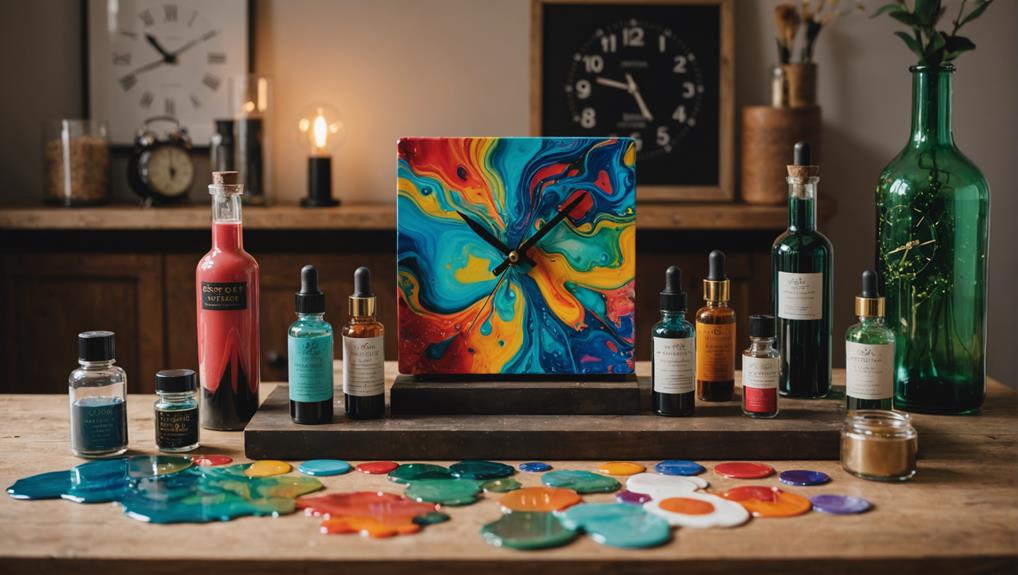
Understanding the curing times of acrylic paint is essential for guaranteeing ideal adhesion and durability of varnishes and sealants. The cure time for acrylic paint typically spans 3-4 weeks to fully dry, but this can be influenced by environmental effects such as temperature and humidity.
In hot, dry climates, it’s generally recommended to wait around 1-2 weeks before applying a sealant, as the paint cures more quickly. Conversely, in humid or cold environments, you might need to allow a longer wait time to achieve complete curing.
It’s important to distinguish between dry time and cure time. Dry time refers to when the paint feels dry to the touch, which can be deceptive since the underlying layers may still be wet. Full cure time guarantees the paint has hardened thoroughly, providing a more durable base for your varnish or sealant.
Skipping the necessary curing period can lead to poor adhesion and reduced longevity of the finish. So, while it might be tempting to rush the process, patience is key.
Giving your acrylic paint sufficient time to cure can make all the difference in achieving a professional and long-lasting result for your fluid art home décor.
Factors Influencing Cure Time
When considering the cure time for your fluid art pieces, it’s essential to understand how factors like temperature, humidity, and paint layer thickness play a role.
Warm and dry environments can speed up the process, while cold and humid conditions can stretch it out.
Additionally, thicker layers of paint will naturally take longer to cure compared to thinner ones.
Temperature and Humidity
Environmental factors such as temperature and humidity greatly influence the cure time of acrylic paint used in fluid art home décor.
When it comes to temperature effects, higher temperatures can be your best friend. Imagine living in a warm, dry climate where your vibrant masterpiece dries in just 1-2 weeks—that’s the magic of heat!
On the flip side, if you’re in a cold or humid environment, patience is key. Humidity control becomes essential as it can slow down the drying process, stretching it well beyond the standard 3-4 weeks.
High humidity isn’t just a minor inconvenience; it can cause dull colors and improper sealing, turning your bright artwork into a lackluster piece.
Paint Layer Thickness
Another critical factor influencing the cure time of acrylic paint in fluid art home décor is the thickness of the paint layers.
When working with fluid art, the paint consistency and the thickness of each layer can dramatically affect how long it takes for the paint to fully cure. Thicker layers simply take longer to dry because there is more material that needs to evaporate and harden.
To guarantee that your paint cures properly and to avoid issues with layer adhesion, consider the following points:
- Paint Consistency: Thicker paint mixtures will naturally take longer to dry compared to more fluid, thinner mixtures.
- Environmental Conditions: In hot, dry climates, it’s usually sufficient to wait 1–2 weeks for the paint to cure. However, in humid or cold environments, you may need to wait considerably longer.
- Application Technique: Applying too much paint at once can create uneven drying conditions, leading to longer overall cure times.
Why Seal Acrylic Paint
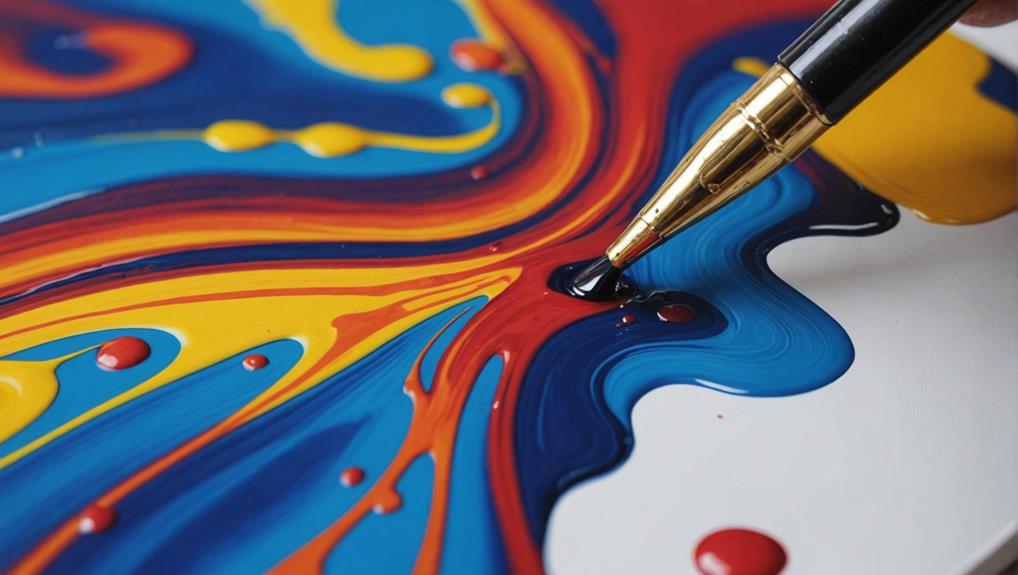
Sealing acrylic paint enhances the artwork’s appearance and longevity by restoring vibrancy and providing a protective layer against wear. When acrylic paint dries, colors may dull, losing their original brightness and saturation. Applying a sealer addresses this issue, reviving the artwork’s vividness and ensuring it remains striking over time.
There are several sealer types available, each offering different acrylic finishes and levels of protection. Brush-on sealers, spray sealers, and resin sealers are common options, with each type yielding unique results. Brush-on sealers allow for precise application, spray sealers provide even coverage, and resin sealers offer a thick, glossy finish. Experimenting with these options can help artists achieve their desired aesthetic and protective qualities.
Environmental factors such as humidity and temperature can affect the curing time of acrylic paint, making the use of sealers beneficial for consistent results. By sealing the paint, artists can protect their work from environmental wear and tear, ensuring durability.
| Sealer Type | Acrylic Finish |
|---|---|
| Brush-on | Precise, customizable |
| Spray | Even coverage |
| Resin | Thick, glossy |
Ultimately, sealing acrylic paint is a valuable step in preserving the vibrancy and longevity of fluid art home décor.
Spray Sealers
Spray sealers, like Rust-Oleum Crystal Clear Enamel, offer a quick and straightforward way to protect your fluid art and enhance its colors.
To achieve the best results, it’s important to use an even back-and-forth motion and apply thin layers to avoid drips.
Additionally, ensuring proper ventilation and allowing adequate drying time between coats are essential for a durable, professional finish.
Application and Technique
When applying spray sealers to fluid art home décor, it is essential to use even back-and-forth motions to guarantee a uniform coat and prevent drips. Mastering these application techniques can greatly impact the final look of your artwork. Spray techniques involve maintaining a consistent distance from the surface, usually around 12 inches, to secure even coverage.
To enhance your spray sealer application, follow these tips:
- Drying Time: Allow at least 30 minutes of drying time between layers to achieve the best results.
- Ventilation: Apply spray sealers outdoors or in a well-ventilated area to mitigate exposure to fumes.
- Reliable Products: Consider using a reliable spray sealer like Rust-Oleum Crystal Clear Enamel for quick and easy application.
Guaranteeing proper ventilation is vital, as the fumes from spray sealers can be quite strong. Additionally, keeping an eye on the drying time between layers is important to avoid tackiness. Using a trusted product like Rust-Oleum Crystal Clear Enamel can make the process smoother.
Furthermore, observing how the colors pop during the application can be a satisfying way to see the sealer’s effectiveness in action.
Benefits and Limitations
Utilizing spray sealers in fluid art home décor projects offers numerous benefits, yet it is important to be aware of their limitations to make informed decisions.
One of the primary spray sealer benefits is the ease and speed of application. Products like Rust-Oleum Crystal Clear Enamel are perfect for covering large areas quickly, saving valuable time. The ability to use smooth back-and-forth motions helps minimize drips and provides a consistently smooth coat, which is essential for preserving the integrity of fluid art pieces.
Another advantage is the enhancement of color vibrancy, making artwork pop with more intensity. Additionally, the variety of finishes—such as satin and matte—allows artists to customize the final look to match their desired aesthetic.
However, these spray sealer benefits come with notable spray sealer limitations. For instance, the application must be done outdoors or in well-ventilated spaces to avoid inhaling potentially harmful fumes. Also, while the drying time is relatively short at about 30 minutes between layers, impatience can lead to compromised results.
Understanding these spray sealer limitations guarantees artists can make the most of their materials while safeguarding their health and achieving the best possible finish for their fluid art home décor projects.
Brush-On Sealers
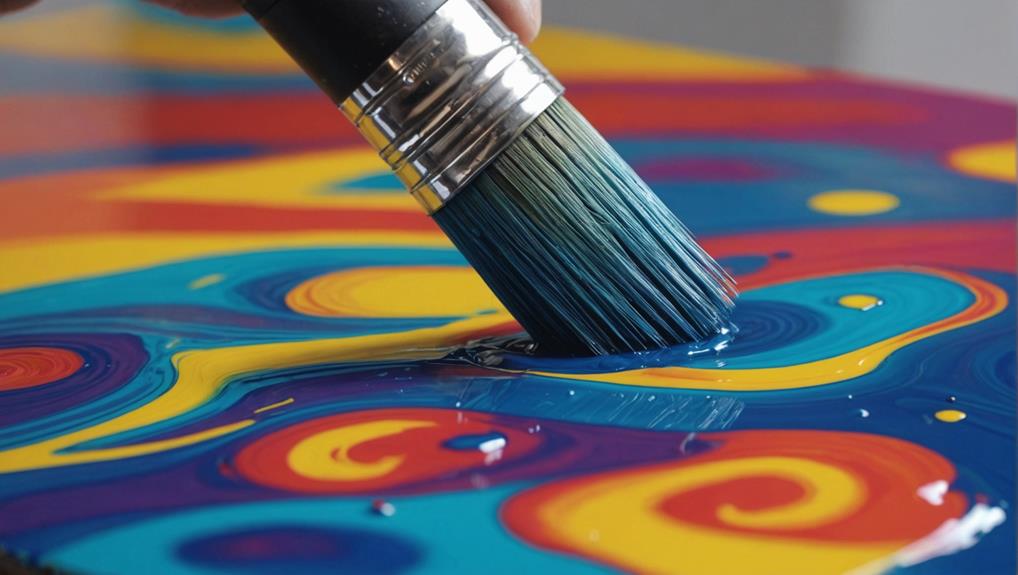
Applying brush-on sealers, such as those offered by Liquitex, requires careful technique to guarantee a durable and flawless finish for fluid art pieces. The brush-on benefits include enhanced control over application and the ability to build up layers gradually. However, mastering the sealing techniques is essential to avoid common pitfalls like visible brush strokes and uneven coverage.
To achieve the best results, consider the following practices:
- Thin Layers: Apply thin layers to prevent drips and ascertain even coverage.
- Drying Time: Allow at least 30 minutes of drying time between layers to achieve a smooth finish.
- Color Vibrancy: Be aware that while brush-on sealers enhance colors, they might slightly dull the vibrancy upon drying. Consider a top coat to restore brightness.
Pour-On Sealers
While brush-on sealers offer control and precision, pour-on sealers, such as Deco Art Top Coat, provide an alternative that yields a smooth, glossy finish ideal for fluid art home décor. These pour on techniques are perfect for bringing out the vibrancy of colors in your fluid art pieces, giving them a professional and polished look. However, applying these sealers requires careful attention to prevent pooling at the edges.
Pour-on sealers create a durable, protective layer but need a dust-free environment to cure properly. Patience is key, as these sealers typically take at least 24 hours to dry to the touch and several weeks to fully cure, depending on environmental conditions. Trying out different pour on brands and techniques can result in varied outcomes, so experimentation is encouraged to find the best match for your project.
Here’s a quick comparison of popular pour-on sealers:
| Brand | Finish Type | Drying Time |
|---|---|---|
| Deco Art Top Coat | Glossy | 24 hours |
| ArtResin | Glossy | 24 hours |
| EnviroTex Lite | Glossy | 48 hours |
| Mod Podge | Glossy | 24 hours |
| Liquitex | Satin | 24 hours |
Resin Sealers
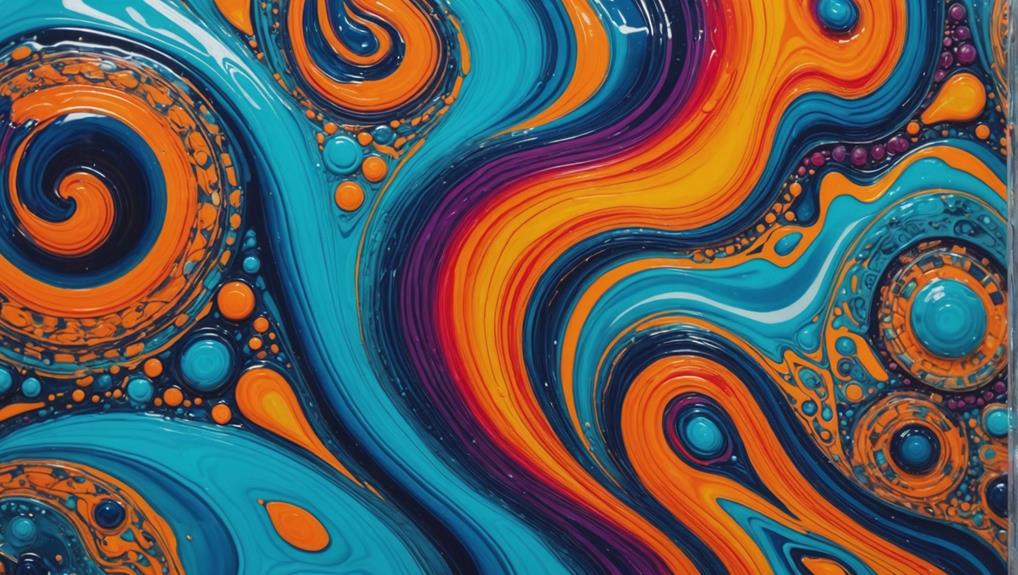
Resin sealers, renowned for their durability and high-gloss finish, are a popular choice for fluid art home décor projects. These sealers, such as Stone Coat Countertops Art Coat, provide maximum UV protection and create a glossy finish that enhances the vibrancy of fluid art pieces.
Additionally, resin sealers can effectively cover minor imperfections like crazing, making them ideal for achieving a smooth, polished look.
Using resin sealers involves understanding different resin types and mastering application techniques. Here are some key points to take into account:
- Resin Types: Epoxy resins are often preferred for their self-leveling properties and clarity, whereas polyester resins might be used for thicker layers.
- Application Techniques: Typically, you’ll need to mix the resin and hardener, pour it onto the surface, and spread it evenly to avoid drips and bubbles.
- Ventilation: Proper ventilation is essential due to the strong fumes emitted during the curing process, ensuring a safe working environment.
Spray Application Tips
When using spray sealers, it’s essential to keep a consistent back-and-forth motion to achieve even coverage and prevent drips.
Allowing at least 30 minutes of drying time between layers guarantees that each coat sets properly for the best results.
Even Coverage Techniques
To achieve an even coverage when applying spray sealers, use consistent back-and-forth motions and maintain a distance of 6-12 inches from the surface. This technique helps guarantee an even coat and prevents the spray pattern from becoming uneven, which can lead to drips and an unsightly finish.
By maintaining a steady hand and even movements, you can achieve a professional look for your fluid art home décor.
Here are some additional tips to help you get the best results:
- Test Spray: Before starting, do a test spray on a piece of cardboard to check the spray pattern and verify the nozzle is working correctly.
- Overlap Slightly: When spraying, overlap each pass slightly to ensure there are no gaps in coverage.
- Keep Moving: Keep the can moving at a consistent speed to prevent excess build-up in one area.
Layer Drying Time
Proper layer drying time is essential to achieving a flawless finish when applying spray sealers to fluid art home décor. Allowing at least 30 minutes between each layer guarantees proper layer adhesion and prevents drips, which can ruin the smooth, even look you’re aiming for.
Using even back-and-forth motions during application is a key drying technique to achieve a smooth finish and avoid uneven coverage. This method not only helps in evenly distributing the sealer but also in revealing how the colors will enhance and look once fully cured. Remember, the wet sealer can give you a sneak peek of the final masterpiece!
Make certain to apply spray sealers outdoors or in a well-ventilated area to minimize exposure to fumes and guarantee safety. Safety first, always!
Also, avoid applying thick layers of spray sealer. Thick layers can lead to drips and an uneven surface texture, which can be quite a headache to fix.
Brush Application Tips
Achieving a flawless finish with brush-on sealers requires attention to technique and the right tools. When using brush techniques, it’s essential to understand the different sealer types and how they interact with the surface of your fluid art. For instance, using Liquitex sealer, apply thin layers to minimize brush strokes and achieve a smoother finish.
Here are some practical tips for achieving the best results:
- Choose a high-quality brush: Soft bristles help reduce the risk of leaving marks or streaks.
- Apply thin layers: This minimizes the appearance of brush strokes. Each layer should dry for at least 30 minutes before applying additional coats.
- Prevent pooling: When using products like Deco Art Top Coat, pour the sealer onto the canvas and gently spread it with a clean brush or spatula.
Choosing Finishes
Selecting the appropriate finish for your fluid art home décor is essential for enhancing its visual appeal and guaranteeing long-term durability.
When choosing finishes, consider how different options will impact the finish aesthetics and sealer compatibility with your artwork.
Spray sealers, such as Rust-Oleum Crystal Clear Enamel, offer a quick and easy application, improving color vibrancy and providing a smooth, even coat.
If you’re looking for a reliable brush-on option, Liquitex sealers can be effective, though they may leave brush strokes, requiring careful application to achieve a seamless finish.
For those seeking a high-gloss and durable result, resin sealers like Stone Coat Countertops Art Coat are excellent. They not only offer maximum UV protection but also cover minor imperfections like crazing, guaranteeing your art remains pristine over time.
The choice between satin and matte finishes can notably influence the overall aesthetic; satin finishes provide a glossy look, while matte finishes lend a more subdued, refined appearance.
Make sure the sealer you pick is compatible with the type of paint and materials used in your fluid artwork. This guarantees the finish adheres properly and maintains the integrity of your creation.
Ventilation Needs

Guaranteeing adequate ventilation is fundamental when applying spray sealers and resins to protect respiratory health and improve air quality. Proper ventilation methods are vital as these products release fumes that can be harmful if inhaled in enclosed spaces. To minimize exposure to toxic vapors, it’s recommended to work outdoors or in a well-ventilated area.
Here are some practical tips to guarantee safe application:
- Open Windows: Maximizing airflow by opening windows enhances air circulation, reducing the concentration of harmful fumes indoors.
- Use Fans: Strategically placing fans near the work area helps to disperse vapors, further improving ventilation and air quality.
- Wear Masks: Safety equipment like masks can filter out harmful particles and vapors, providing an extra layer of protection for your respiratory system.
In addition to improving safety, good ventilation also aids in faster drying times, which is particularly important for thicker applications.
Testing Different Sealers
Evaluating various sealers is essential to determine their impact on the vibrancy, durability, and overall finish of fluid art pieces. Each type of sealer, whether spray, brush-on, or resin, can uniquely influence the final look and feel of your artwork. Carrying out sealer comparisons allows artists to see which products best enhance colors and protect the piece from damage.
When testing, it’s important to apply sealers in thin layers, with a 30-minute drying time between each application. This helps avoid drips and guarantees an even coat. Keep the environment well-ventilated, especially when using spray or resin sealers, to maintain safety and achieve the best results.
Here’s a quick comparison table to help you decide:
| Sealer Type | Pros | Cons |
|---|---|---|
| Spray | Easy application, quick drying | Can be toxic, requires ventilation |
| Brush-on | Precise control, less mess | Time-consuming, potential brush marks |
| Resin | High-gloss finish, durable | Expensive, requires ventilation |
Frequently Asked Questions
How to Seal Fluid Art?
To seal fluid art, employ sealing techniques such as spray sealers for ease of application, brush-on varnish types for precision, or resin sealers for UV protection and durability. Allow 30 minutes drying time between layers. Guarantee proper ventilation.
What Is the Best Surface for Fluid Art?
The best surface for fluid art depends on the desired outcome. Canvas choice is popular for its lightness and flexibility, while wood panels provide sturdiness. Substrate selection should consider the final display environment and specific artistic needs.
How Do You Protect Fluid Art?
To protect fluid art, employ art preservation techniques such as sealing with varnishes. Varnish application tips include waiting for the paint to cure, applying thin, even layers, using proper ventilation, and considering UV-protective resin sealers.
What Is the Best Protection for Oil Paintings?
The best protection for oil paintings involves employing proper oil painting techniques and meticulous varnish application. Damar varnish and synthetic varnishes are recommended, ensuring durability and UV protection. Apply thin, even layers and perform regular maintenance for ideal results.
Conclusion
Varnishing and sealing fluid art home décor is crucial to preserve the artwork’s vibrancy and longevity.
Understanding drying and curing times, along with factors influencing these processes, ensures optimal results.
Proper brush application techniques and choosing appropriate finishes further enhance the final appearance.
Adequate ventilation is necessary to ensure safety, while testing different sealers allows for informed choices.
Employing these practices guarantees that fluid art remains protected and visually appealing over time.

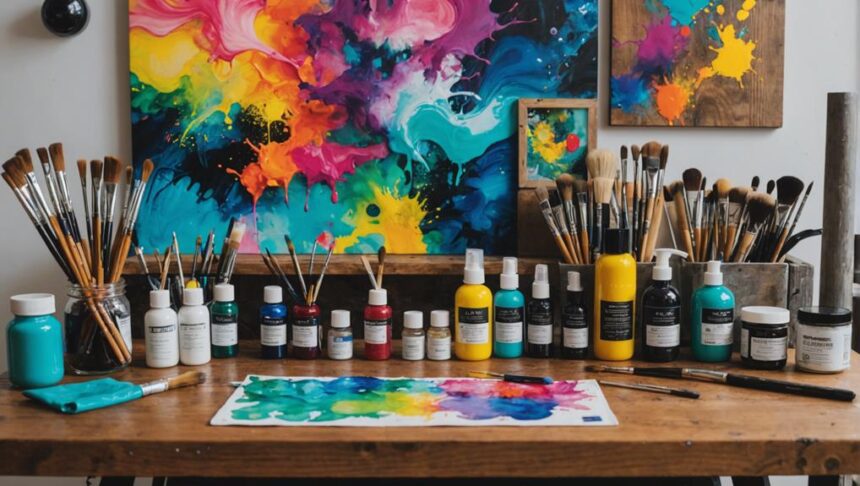
Leave a Reply